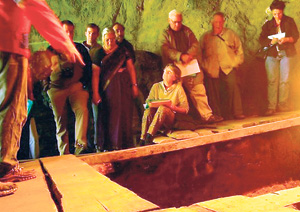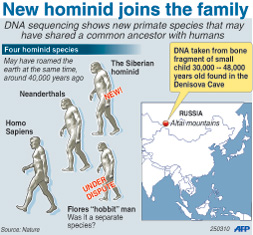PARIS (AFP) - A hominid that lived in southern Siberia some 40,000 years ago could be a new branch on the human family tree, a finding that would rewrite Homo's exodus from Africa and his conquest of the Earth.
In a technical feat reported on Wednesday, scientists sequenced DNA from the bone fragment of a pinkie finger, possibly from a small child, found in a cave in the Alta Mountains.
The bone found in Denisova Cave was extricated in 2008 from a soil layer carbon-dated to between 30,000 to 48,000 years ago.
 |
| A recent picture released by Nature Journal on March 24, 2010 shows the archaelogical team inside the Denisova cave in the Siberia's Altai Mountains. AFP |
|
Teased from a cellular component called mitochondria, the genome was compared to the code of our extinct cousins the Neanderthals, of Homo sapiens, the bonobo and chimpanzee.
The Siberian hominid, the investigation found, had some 400 genetic differences, which makes it a candidate for being a distinct species of Homo, as the genus for humans and closely related primates is known. It, us and the Neanderthals all shared a common ancestor who lived around a million years ago, say the investigators.
"It's absolutely amazing... It's some new creature that's not been on our radar screen so far," co-researcher Svante Paabo told reporters.
The study, published in the weekly journal Nature, is led by Johannes Krause of Germany's Max Planck Institute for Evolutionary Anthropology. Members of the team previously sequenced most of the genome of the Neanderthal.
If their findings are confirmed, much of the early tale of human settlement will have to be revamped.
A common narrative is this: Homo arose in east Africa. The first hominid to venture beyond this cradle was Homo erectus, around 1.9 million years ago.
That exodus was followed much later by two other known waves.
The first involved either Homo heidelbergensis or Homo rhodesiensis hominids, between 300,000 and 500,000 years ago, who were the forerunners of the Neanderthals, our cousins.
The second were Homo sapiens, as anatomically modern man is known, who left Africa perhaps 50,000 years ago.
If a "molecular clock" calculation of DNA change is right, the Denisova hominid lineage came from Africa, says the study.
Yet its ancestor was not H. erectus, nor a descendent of the H. erectus populations that moved to Europe -- but a member of a previously unknown out-of-Africa movement.
Until just recently, it was also thought the only human species inhabiting the planet around 40,000 years ago were us and the Neanderthals, who had only a little more time to run before they mysteriously disappeared.
The two-species picture dramatically changed in 2003, when "hobbit hominids" -- metre-high (3.25-feet) humans with brains the size of a grapefruit -- showed up in fossilised form on the Indonesian island of Flores.
If the "hobbits" and the Denisova human are accepted as a separate species that brings to four the tally of hominids who were all living at the same time and, in some cases, quite close to each other.
For instance, the Altai mountains have yielded evidence that H. sapiens made stone tools there, while Neanderthals lived less than 100 kilometers (60 miles) from the Denisova Cave.
If so, what happened?
Did H. sapiens, bigger brained and smarter in communication, wipe out the other species?
Were the other species wiped out by some natural phenomenon or food crisis to which they could not adapt?
Or was there interbreeding, meaning that the extinct species are -- in a purely DNA sense -- living today through some genes bequeathed to all of us?
"All the theories are still open," University of Manchester specialist Terry Brown told AFP. "But the interesting thing is that they've just become more complex." |



